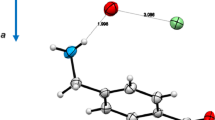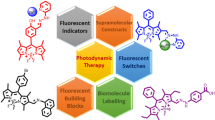Abstract
A new Zn(II)-btc coordination polymer 1 (H3btc = benzene-1,3,5-tricarboxylic acid) containing protonated acridines was synthesized by hydrothermal reaction at 165 °C for 3 days and characterized by FT-IR, UV–Vis, Fluorescence, TGA measurements and single-crystal/powder X-ray crystallography. The crystallographic data for 1: monoclinic, P21/n, a = 11.0100(5), b = 16.7104(7), c = 11.7492(5) Å, β = 98.735(2), V = 2136.56(16) Å3, Z = 4, T = 130(2) K, Dc = 1.572 g cm−3, F(000) = 1036, μ(Mo Kα) = 1.205 mm−1, GOF = 1.005. R 1 = 0.0427, wR 2 = 0.1410 [I > 2σ(I)]. Structural analysis also revealed that the btc3− ligands bridge four-coordinate Zn(II) centres to form a 2-D grid-like layer network on the bc plane. The protonated acridines fill up the cavities formed between adjacent layers and combine the 2-D layers to generate a non-interpenetrating 3-D supramolecular framework through the hydrogen bondings and π···π packing interactions. The fluorescence investigation disclosed that 1 shows multiband emissions over a wide range.
Graphical Abstract
A non-interpenetrating 3-D supramolecular framework, built from Zn(II) ions and benzene-1,3,5-tricarboxylate ligands, encapsulates the protonated acridines and exhibits multiband fluorescence emissions over a wide range.








Similar content being viewed by others
References
Dang DB, Wu PY, He C, Xie Z, Duan CY (2010) J Am Chem Soc 132:14321–14323
Li PZ, Lu XM, Liu B, Wang S, Wang XJ (2007) Inorg Chem 46:5823–5825
Sava DF, Kravtsov VC, Nouar F, Wojtas L, Eubank JF, Eddaoudi M (2008) J Am Chem Soc 130:3768–3770
Lei BF, Li B, Zhang HR, Zhang LM, Li WL (2007) J Phys Chem C 111:11291–11301
Chen SM, Zhang J, Wu T, Feng PY, Bu XH (2009) J Am Chem Soc 131:16027–19029
Ma S, Zhou HC (2006) J Am Chem Soc 128:11734–11735
Oisaki K, Li QW, Furukawa H, Czaja AU, Yaghi OM (2010) J Am Chem Soc 132:9262–9264
Lin W, Evans OR, Xiong RG, Wang Z (1998) J Am Chem Soc 120:13272–13273
Andruh M, Costes JP, Diaz C, Gao S (2009) Inorg Chem 48:3342–3359
Jia LH, Li RY, Duan ZM, Jiang SD, Wang BW, Wang ZM, Gao S (2011) Inorg Chem 50:144–154
Yang EC, Zhao HK, Ding B, Wang XG, Zhao XJ (2007) Cryst Growth Des 7:2009–2015
Dai YM, Ma E, Tang E, Zhang J, Li ZJ, Huang XD, Yao YG (2005) Cryst Growth Des 5:1313–1315
Hu S, Meng ZS, Tong ML (2010) Cryst Growth Des 10:1742–1748
Wang ZQ, Kravtsov VC, Zaworotko MJ (2005) Angew Chem 44:2877–2880
Kim J, Chen BL, Reineke TM, Li HL, Eddaoudi M, O’Keeffe M, Yaghi OM (2001) J Am Chem Soc 123:8239–8247
Chui SSY, Lo SMF, Charmant JPH, Orpen AG, Williams ID (1999) Science 283:1148–1150
Shi Z, Li GH, Wang L, Gao L, Chen XB, Hua J, Feng SH (2004) Cryst Growth Des 4:25–27
Rosi NL, Kim J, Eddaoudi M, Chen BL, O’Keeffe M, Yaghi OM (2005) J Am Chem Soc 127:1504–1518
Xie JL, Han ZG, Pei WB, Zou Y, Ren XM (2011) Inorg Chem Commun 14:1266–1270
Liu W, Yu J, Jiang J, Yuan L, Xu B, Liu Q, Qu B, Zhang G, Yan C (2011) CrystEngComm 13:2764–2773
Cheng W, Wang JY, Chen C, Yue Q, Yaun HM, Chan JS, Wang SN (2003) Inorg Chem 42:944–946
Xiong RG, Zuo JL, You XZ, Abrahams BF, Bai ZP, Che CM, Fun HK (2000) Chem Commun 20:2061–2062
Wang ST, Hou Y, Wang EB, Li YG, Xu L, Peng J, Liu SX, Hu CW (2003) New J Chem 1144–1147
Sheldrick GM (2008) Acta Cryst A64:112–122
Sheldrick GM (1998) SHELX97, Programs for crystal structure analysis. Institüt für Anorganische Chemie der Universität, Göttingen
Sheldrick GM (1996) SADABS, V2.01, Empirical Absorption Correction Program, Institüt für Anorganische Chemie der Universität, Göttingen
Takashima H, Tara C, Namikawa S, Kato T, Araki Y, Ito O, Tsukahara K (2006) J Phys Chem B 110:26413–26423
Huang XY, Li J (2007) J Am Chem Soc 129:3157–3162
Wei KJ, Ni J, Xie YS, Liu QL (2007) Inorg Chem Commun 10:279–282
Wei KJ, Xie YS, Ni J, Zhang M, Liu QL (2006) Cryst Growth Des 6:1341–1350
Xie JL, Abrahams B, Wedd A (2008) Chem Commun 576–578
Xu J, Yao X, Huang L, Li Y, Zheng H (2011) CrystEngComm 13:857–865
Acknowledgments
Financial support by the Monash Fellowship Program (JX) is gratefully acknowledged. YZ thanks the support by the National Natural Science Foundation of China (20901067).
Author information
Authors and Affiliations
Corresponding author
Rights and permissions
About this article
Cite this article
Pei, W., Han, Z., Xie, J. et al. A New Coordination Polymer of Zn(II)-btc (H3btc = Benzene-1,3,5-tricarboxylic acid) with Protonated Acridine: Synthesis, Crystal Structure and Spectroscopic Properties. J Chem Crystallogr 42, 1007–1013 (2012). https://doi.org/10.1007/s10870-012-0349-y
Received:
Accepted:
Published:
Issue Date:
DOI: https://doi.org/10.1007/s10870-012-0349-y




